| Listing 1 - 10 of 671 | << page >> |
Sort by
|
Book
ISBN: 9783540320197 Year: 2005 Publisher: Berlin Heidelberg Springer-Verlag GmbH.
Abstract | Keywords | Export | Availability | Bookmark
 Loading...
Loading...Choose an application
- Reference Manager
- EndNote
- RefWorks (Direct export to RefWorks)
It is always a special honor to chair the European Dependable Computing C- ference (EDCC). EDCC has become one of the well-established conferences in the ?eld of dependability in the European research area. Budapest was selected as the host of this conference due to its traditions in organizing international scienti?c events and its traditional role of serving as a meeting point between East and West. EDCC-5 was the ?fth in the series of these high-quality scienti?c conf- ences. In addition to the overall signi?cance of such a pan-European event, this year's conference was a special one due to historic reasons. The roots of EDCC date back to the moment when the Iron Curtain fell. Originally, two groups of scientists from di?erent European countries in Western and Eastern Europe - who were active in research and education related to dependability created a - joint forum in order to merge their communities as early as in 1989. This trend has continued up to today. This year's conference was the ?rst one where the overwhelming majority of the research groups belong to the family of European nations united in the European Union. During the past 16 years we observed that the same roots in all the professional, cultural and scienti?c senses led to a seamless integration of these research communities previously separated ar- ?cially for a long time. EDCC has become one of the main European platforms to exchange new - searchideasinthe?eldofdependability.
Book
ISBN: 9783642048180 9783642048173 Year: 2010 Publisher: Berlin, Heidelberg Springer Berlin Heidelberg
Abstract | Keywords | Export | Availability | Bookmark
 Loading...
Loading...Choose an application
- Reference Manager
- EndNote
- RefWorks (Direct export to RefWorks)
Innovations in hardware architecture, like hyper-threading or multicore processors, mean that parallel computing resources are available for inexpensive desktop computers. In only a few years, many standard software products will be based on concepts of parallel programming implemented on such hardware, and the range of applications will be much broader than that of scientific computing, up to now the main application area for parallel computing. Rauber and Rünger take up these recent developments in processor architecture by giving detailed descriptions of parallel programming techniques that are necessary for developing efficient programs for multicore processors as well as for parallel cluster systems and supercomputers. Their book is structured in three main parts, covering all areas of parallel computing: the architecture of parallel systems, parallel programming models and environments, and the implementation of efficient application algorithms. The emphasis lies on parallel programming techniques needed for different architectures. The main goal of the book is to present parallel programming techniques that can be used in many situations for many application areas and which enable the reader to develop correct and efficient parallel programs. Many examples and exercises are provided to show how to apply the techniques. The book can be used as both a textbook for students and a reference book for professionals. The presented material has been used for courses in parallel programming at different universities for many years.
Computer Science. --- Programming Techniques. --- Computer Communication Networks. --- Computational Science and Engineering. --- System Performance and Evaluation. --- Processor Architectures. --- Communications Engineering, Networks. --- Computer science. --- Computer system performance. --- Telecommunication. --- Informatique --- Réseaux d'ordinateurs --- Télécommunications --- Programmation parallèle (informatique) --- Parallel programming (Computer science)
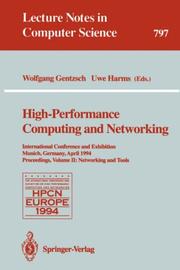
ISBN: 038757980X 354057980X 9783540579809 9780387579801 354048406X Year: 1994 Publisher: Berlin : Springer-Verlag,
Abstract | Keywords | Export | Availability | Bookmark
 Loading...
Loading...Choose an application
- Reference Manager
- EndNote
- RefWorks (Direct export to RefWorks)
High-performance computing and networking (HPCN) is driven by several initiatives in Europe, the United States, and Japan. In Europe several groups encouraged the Commission of the European Communities to start an HPCN programme. This two-volume work presents the proceedings of HPCN Europe 1994. Volume 1 includes sections on: keynote talks, HPCN and visualization in industry, algorithms for engineering applications, electrical computer-aided engineering, computational fluid dynamics, computational chemistry, materials science, weather simulations, environmental applications and climate, high-energy physics and astrophysics, neuroscience and neural networks, and database applications.
Computer Communication Networks. --- Software engineering. --- Computer system performance. --- Computer science. --- Special Purpose and Application-Based Systems. --- System Performance and Evaluation. --- Programming Techniques. --- Software Engineering. --- Programming Languages, Compilers, Interpreters. --- Informatics --- Science --- Computer software engineering --- Engineering
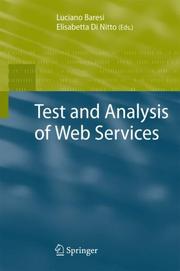
ISBN: 1281070335 9786611070335 3540729127 3540729119 3642092004 Year: 2007 Publisher: Berlin [Germany] ; New York : Springer,
Abstract | Keywords | Export | Availability | Bookmark
 Loading...
Loading...Choose an application
- Reference Manager
- EndNote
- RefWorks (Direct export to RefWorks)
The service-oriented approach has become more and more popular, now allowing highly integrated and yet heterogeneous applications. Web services are the natural evolution of conventional middleware technologies to support Web-based and enterprise-level integration. The highly dynamic characteristics of service-oriented applications means their validation is a continuous process that often runs in parallel with execution. It is not possible to clearly distinguish between the predeployment validation of a system and its use, nor is it possible to guarantee that the checks passed at a certain time will be passed at a later time and in the actual execution environment as well. Baresi and Di Nitto have put together the first reference on all aspects of testing and validating service-oriented architectures, taking into account these inherent intricacies. The contributions by leading academic and industrial research groups are structured into four parts on: static analysis to acquire insight into how the system is supposed to work; testing techniques to sample its actual behavior; monitoring to probe its operational performance; and nonfunctional requirements like reliability and trust. This monograph is an initial source of knowledge for researchers in both academia and industry in the field of service-oriented architecture validation and verification approaches. They will find a comprehensive survey of state-of-the-art approaches as well as techniques and tools to improve the quality of service-oriented applications.
Web services. --- Web services --- Testing. --- Application software --- Cloud computing --- Software engineering. --- Computer system performance. --- Information Systems Applications (incl. Internet). --- Software Engineering. --- System Performance and Evaluation. --- Computer software engineering --- Engineering --- Application software. --- Computer system failures. --- Computer failures --- Computer malfunctions --- Computer systems --- Failure of computer systems --- System failures (Engineering) --- Fault-tolerant computing --- Application computer programs --- Application computer software --- Applications software --- Apps (Computer software) --- Computer software --- Failures
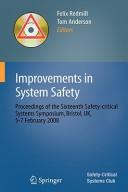
ISBN: 1281141267 9786611141264 1848001002 1848000995 Year: 2008 Publisher: New York ; London : Springer,
Abstract | Keywords | Export | Availability | Bookmark
 Loading...
Loading...Choose an application
- Reference Manager
- EndNote
- RefWorks (Direct export to RefWorks)
Improvements in System Safety contains the full complement of papers presented at the sixteenth annual Safety-critical Systems Symposium, held at Bristol, UK, in February 2008. The Symposium is for engineers, managers and academics in the field of safety, across all industry sectors, and so the papers included in this volume offer a wide-ranging coverage of major safety issues as well as a good blend of academic research and industrial experience. They include discussions of some of the most recent developments in the field. The first paper reflects a tutorial – on The Safety Case – held on the first day of the Symposium. The subsequent 14 papers are presented under the headings of the Symposium’s sessions: Themes Reprised from SSS ’07; The Safety Case; Safety Culture; Human Factors; Achieving and Improving System Safety; Safety and Risk Analysis. This book will be of interest to both academics and practitioners working in the safety-critical systems arena.
Industrial safety --- Automatic control --- Reliability --- Information Technology --- Software Engineering --- Software engineering. --- Computer system performance. --- Software Engineering. --- System Performance and Evaluation. --- Computer software engineering --- Engineering --- Computer system failures. --- Computer failures --- Computer malfunctions --- Computer systems --- Failure of computer systems --- System failures (Engineering) --- Fault-tolerant computing --- Failures
Book
ISBN: 3319081446 3319081438 Year: 2014 Publisher: Cham : Springer International Publishing : Imprint: Springer,
Abstract | Keywords | Export | Availability | Bookmark
 Loading...
Loading...Choose an application
- Reference Manager
- EndNote
- RefWorks (Direct export to RefWorks)
Current advances in High Performance Computing (HPC) increasingly impact efficient software development workflows. Programmers for HPC applications need to consider trends such as increased core counts, multiple levels of parallelism, reduced memory per core, and I/O system challenges in order to derive well performing and highly scalable codes. At the same time, the increasing complexity adds further sources of program defects. While novel programming paradigms and advanced system libraries provide solutions for some of these challenges, appropriate supporting tools are indispensable. Such tools aid application developers in debugging, performance analysis, or code optimization and therefore make a major contribution to the development of robust and efficient parallel software. This book introduces a selection of the tools presented and discussed at the 7th International Parallel Tools Workshop, held in Dresden, Germany, September 3-4, 2013. .
High performance computing --- Research. --- Computer science. --- Computer system performance. --- Computational Science and Engineering. --- System Performance and Evaluation. --- Computer Applications. --- Informatics --- Science --- Computer mathematics. --- Computer system failures. --- Application software. --- Application computer programs --- Application computer software --- Applications software --- Apps (Computer software) --- Computer software --- Computer failures --- Computer malfunctions --- Computer systems --- Failure of computer systems --- System failures (Engineering) --- Fault-tolerant computing --- Computer mathematics --- Electronic data processing --- Mathematics --- Failures
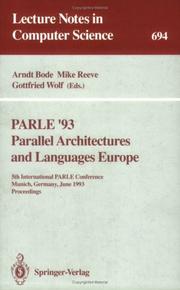
ISBN: 3540568913 0387568913 3540477799 Year: 1993 Volume: vol 694 Publisher: Berlin : Springer-Verlag,
Abstract | Keywords | Export | Availability | Bookmark
 Loading...
Loading...Choose an application
- Reference Manager
- EndNote
- RefWorks (Direct export to RefWorks)
Parallel processing offers a solution to the problem of providing the processing power necessary to help understand and master the complexity of natural phenomena and engineering structures. By taking several basic processing devices and connecting them together the potential exists of achieving a performance many times that of an individual device. However, building parallel application programs is today recognized as a highly complex activity requiring specialist skills and in-depth knowledge. PARLE is an international, European based conference which focuses on the parallel processing subdomain of informatics and information technology. It is intended to become THE European forum for interchange between experts in the parallel processing domain and to attract both industrial and academic participants with a technical programme designedto provide a balance between theory and practice. This volume contains the proceedings of PARLE '93. The PARLE conference came into existence in 1987 as an initiative from the ESPRIT I programme and the format was revised in 1991/92. PARLE '93 is the second conference with the new format and was held in Munich.
Computer architecture --- Parallel processing (Electronic computers) --- Congresses. --- Parallel computers --- Congresses --- Parallel programming (Computer science) --- Computer network architectures. --- Computer science. --- Computer Communication Networks. --- Software engineering. --- Computer system performance. --- Computer System Implementation. --- Processor Architectures. --- Special Purpose and Application-Based Systems. --- System Performance and Evaluation. --- Programming Techniques. --- Computer software engineering --- Engineering --- Informatics --- Science --- Architectures, Computer network --- Network architectures, Computer
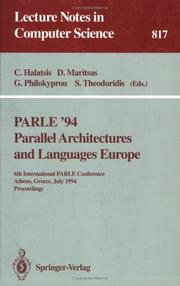
ISBN: 0387581847 3540581847 3540484779 Year: 1994 Volume: 817 Publisher: Berlin : Springer-Verlag,
Abstract | Keywords | Export | Availability | Bookmark
 Loading...
Loading...Choose an application
- Reference Manager
- EndNote
- RefWorks (Direct export to RefWorks)
This volume presents the proceedings of the 5th International Conference Parallel Architectures and Languages Europe (PARLE '94), held in Athens, Greece in July 1994. PARLE is the main Europe-based event on parallel processing. Parallel processing is now well established within the high-performance computing technology and of stategic importance not only to the computer industry, but also for a wide range of applications affecting the whole economy. The 60 full papers and 24 poster presentations accepted for this proceedings were selected from some 200 submissions by the international program committee; they cover the whole field and give a timely state-of-the-art report on research and advanced applications in parallel computing.
Computer architecture --- Parallel processing (Electronic computers) --- Congresses. --- Congresses --- Computer network architectures. --- Computer science. --- Computer Communication Networks. --- Software engineering. --- Computer system performance. --- Computer System Implementation. --- Processor Architectures. --- Special Purpose and Application-Based Systems. --- System Performance and Evaluation. --- Programming Techniques. --- Computer software engineering --- Engineering --- Informatics --- Science --- Architectures, Computer network --- Network architectures, Computer
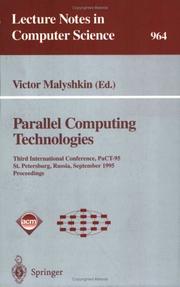
ISBN: 3540602224 3540447547 9783540602224 Year: 1995 Volume: 964 Publisher: Berlin : Springer-Verlag,
Abstract | Keywords | Export | Availability | Bookmark
 Loading...
Loading...Choose an application
- Reference Manager
- EndNote
- RefWorks (Direct export to RefWorks)
This book constitutes the proceedings of the Third International Conference on Parallel Computing Technologies, PaCT '95, held in St. Petersburg, Russia in September 1995. The volume presents 45 revised full papers selected from a total of 98 submissions, including six invited presentations. The proceedings is organized in parts on theory, software, hardware and architecture, and applications to large-scale problems. Parallel processing technologies are shown to be the touchstone of parallel theories, models, languages, and programming systems.
Parallel processing (Electronic computers) --- Congresses. --- Congresses --- Computer network architectures. --- Computer science. --- Computer Communication Networks. --- Software engineering. --- Computer system performance. --- Computer System Implementation. --- Processor Architectures. --- Special Purpose and Application-Based Systems. --- System Performance and Evaluation. --- Programming Techniques. --- Computer software engineering --- Engineering --- Informatics --- Science --- Architectures, Computer network --- Network architectures, Computer --- Computer architecture --- Parallel processing (Electronic computers) - Congresses.
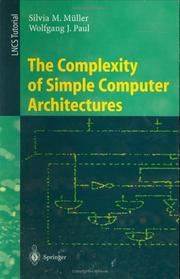
ISBN: 3540605800 3540477748 Year: 1995 Volume: 995 Publisher: Berlin : Springer-Verlag,
Abstract | Keywords | Export | Availability | Bookmark
 Loading...
Loading...Choose an application
- Reference Manager
- EndNote
- RefWorks (Direct export to RefWorks)
This book presents a formal model for evaluating the cost effectiveness of computer architectures. The model can cope with a wide range of architectures, from CPU design to parallel supercomputers. To illustrate the formal procedure of trade-off analyses, several non-pipelined design alternatives for the well-known RISC architecture called DLX are analyzed quantitatively. It is formally proved that the interrupt mechanism proposed for the DLX architecture handles nested interrupts correctly. In an appendix all programs to compute the cost and cycle time of the designs described are listed in C code. Running these simple C programs on a PC is sufficient to verify the results presented. The book addresses design professionals and students in computer architecture.
Computer architecture --- Computerarchitectuur --- Ordinateurs--Architecture --- Computer architecture. --- Microprogramming. --- Computer science. --- Computer system performance. --- Electronics. --- Logic design. --- Control Structures and Microprogramming. --- Processor Architectures. --- System Performance and Evaluation. --- Arithmetic and Logic Structures. --- Electronics and Microelectronics, Instrumentation. --- Logic Design. --- Design, Logic --- Design of logic systems --- Digital electronics --- Electronic circuit design --- Logic circuits --- Machine theory --- Switching theory --- Electrical engineering --- Physical sciences --- Informatics --- Science --- Computer programming
| Listing 1 - 10 of 671 | << page >> |
Sort by
|

 Search
Search Feedback
Feedback About UniCat
About UniCat  Help
Help News
News